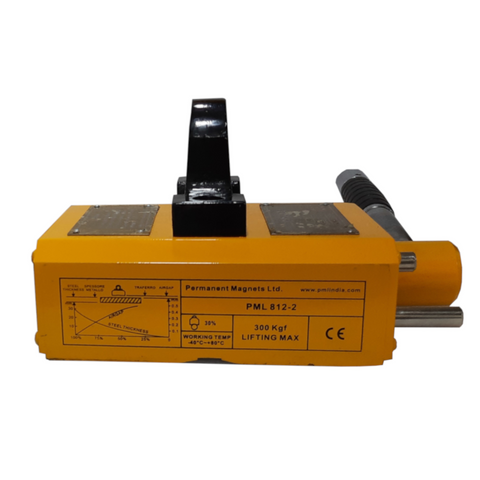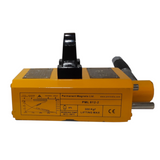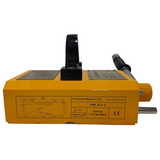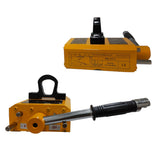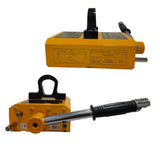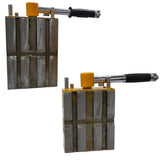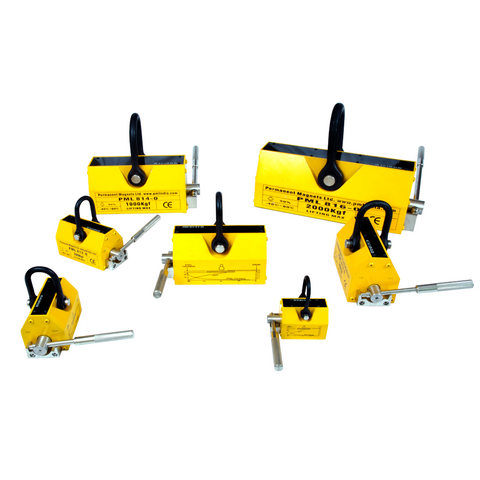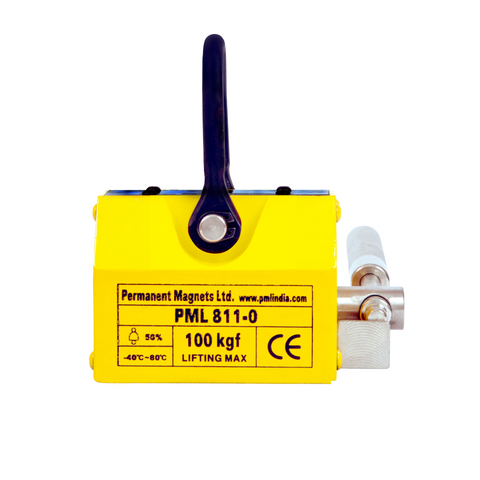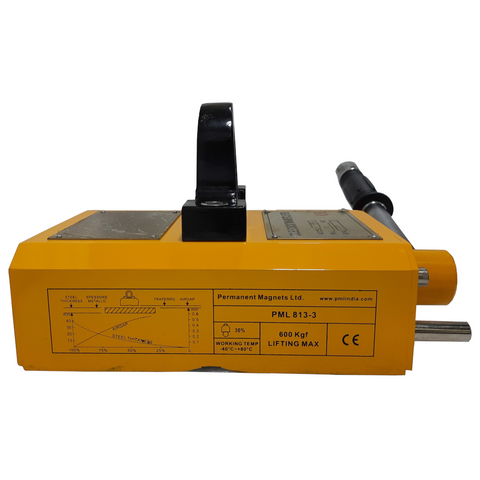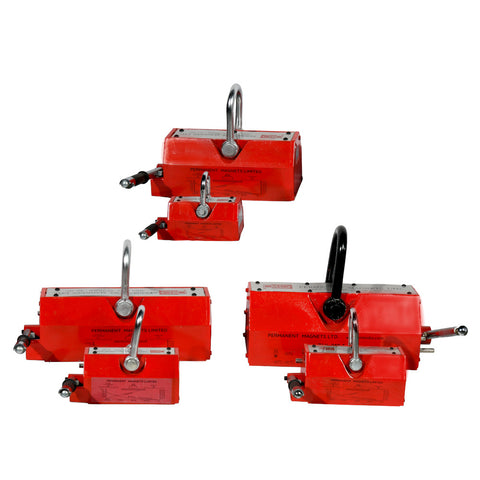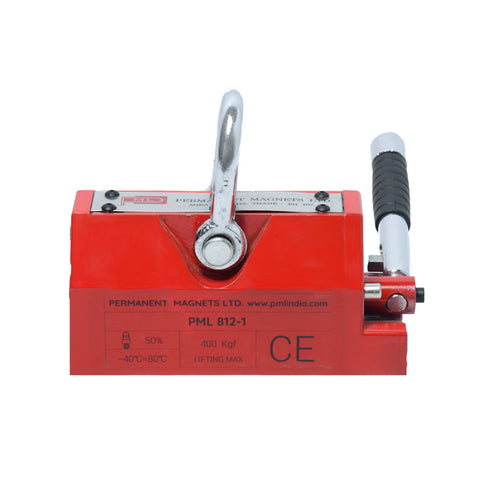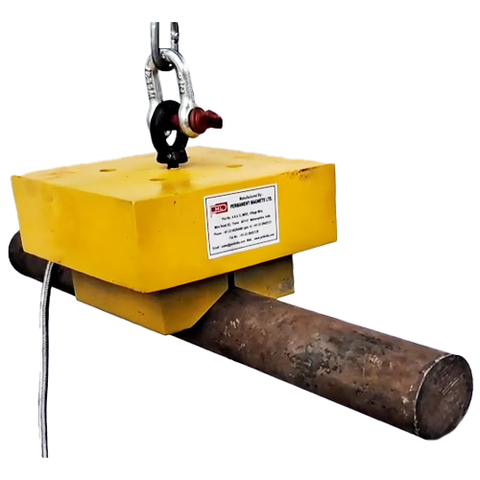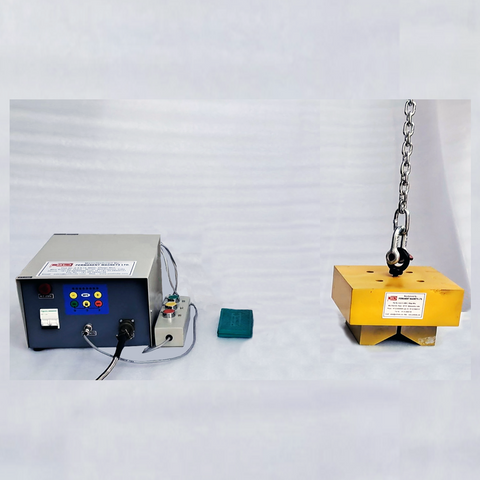Product Description
PML Double Circuit magnetic lifter uses high quality & strong NdFeB/ Rare earth magnets. Designed with four poles design as compared to two poles in conventional lifters.
This Lifters has a Double Magnetic Circuit and is useful for lifting thinner sheets less than 5 mm. The Double Magnetic Circuit also helps in reduced effort in turning the ON-OFF lever which otherwise is not possible for thin sheet lifting application.
Depending upon the length & breadth of thinner sheet more no. of lifters are required to counter waviness and sag of thinner sheets.
The multiple lifters need to be hung on a spreader beam for bigger sheet lifting application. Multiple magnetic lifters can also be used for lifting / holding of big size (L x W) steel plates
PML Double Circuit magnetic lifters can be used for connecting MS plates during handling operations.
Hence PML double circuit magnetic lifter is easy to operate, small in size and lightweight. Because of which it can be used as a hoisting device in industrial applications, plants, fabrication shops, warehouses, docks & transportation industry.
By using PML double circuit magnetic lifters you can improve working conditions and increase your working efficiency.
Features:
- Used for lifting thin plates up to 5 mm thick.
- Double circuit design assures more uniform usage of magnetic force.
- Double circuit design assures larger contact areas with more magnetic strength, assuring huge safety during operation.
- Easy to use ON/OFF Lever
- Zero electricity required.
- Forged hook for high mechanical strength and durability
- Designed for safety and lightweight
- No maintenance and operating cost
- 2.5 times rated capacity factor of safety to meet all safety standards for under the hook devices.
- Test Certificates for safety factor from government approved third party testing.
- No damage to the work-piece being lifted
- Very Compact and convenient to use.
Benefits
- Lifting Magnets use space more effectively. Eliminates the need to gauge and increase stacking height
- As less as one operator can move large and heavy work-piece safely and easily using Magnetic Lifters
- Lifting Magnets save labor and time - improves productivity.
Constructions
Permanent Magnet Lifters have a strong magnetic field path produced by NdFeB magnetic materials. "On" and "Off" of the magnetic path is controlled by turning the lever manually. There is a hook on the top of the double circuit magnetic Lifter for lifting.
Operating Instructions
- The work-piece surface (magnetic ferrous surface) and the magnet pole surface must be clean and smooth to achieve maximum efficiency. Ground and machined surface are ideal but a good clean surface on a ferrous or casting is acceptable provided a sufficiently flat area available for a good magnetic contract with the work-piece
- There should be no air gap/inclusions between the magnet pole and the job surface
- Place the magnet on the ferrous surface. Unlock the lever by pulling it out and then turn it to the “ON“ position. Once it is made “ON”, lock it by releasing it. For making it “OFF”, please follow the similar procedure. (Do not place on wooden surface OR non-magnetic surface - it will not be possible to operate Lever to “ON” position)
- Move the load smoothly, avoid shocks and collisions
- To place/drop the lifted material, operate the lever to the “OFF” position
When not in use:
- Apply Grease / Oil on Magnetic Poles surface to prevent it from rusting and
- Place it on a thick wooden plank to safeguard its Magnetic poles from any damages, scratches, etc.
Safety Instructions:
- Place the magnet on the Ferrous Surface in the “OFF” position and then make it “ON”. Do not make it ON without keeping it on a ferrous surface
- The magnet is to be placed on the center, i.e. centering to the center of gravity of the load and then lift
- While handling the load, no person should be allowed in the immediate danger zone
- Ensure that the lever is made “OFF” after resting the load at the desired place in the balance position
Important Factors for the Safe Operation of Lifting Devices:
Load characteristics other than just weight must be considered in order to determine the weight that any magnetic lifter can lift. This statement is true for any lifting magnets because they all operate on the same fundamental laws of Physics. Magnetic power is pictured as lines of force flowing from North to the South Pole. Anything that limits the flow of these magnetic lines of force obviously reduces the magnet’s lifting ability. There are four important factors that limit the flow of these lines of force.
Load Surface Conditions
Magnetic lines of force do not flow easily through the air, they need iron in order to flow freely. Therefore, anything that creates an air gap between a magnet and the load, limits the flow of magnetic force and thus reduces the lifting capacity of a magnet. Paper, dirt, rust, paint and scale act in the same way as air, so also a rough surface finish between the magnet and the load.
Load Length and Width
When the length or width of a load increases, it ceases to lie flat and the load begins to drop at the edges. The drooping/sagging of the load can create an air gap between the load and the magnet. If this occurs then the lifting capacity of the magnet is reduced.
Load Thickness
Magnetic lines of force are more effective when they flow through iron instead of air. The thicker the load, the more the lines of magnetic force. After a certain thickness of load, no more lines of force will flow because the magnet has reached its full capacity. Thin material (load) means less iron available and thus fewer lines of magnetic force flow from the magnet into the load. Therefore, the lifting ability of the magnet is reduced. Every magnet is rated for minimum thickness of load to reach full lifting capacity. Below such thickness of load will berate the lifting capacity of the magnet. In general, it can be said the load must be thicker than the width of one of the magnet poles.
Load Alloy
Low carbon steels, such as soft Iron or Mild Steel are nearly as good conductors of magnetic lines of force as pure iron. However, if the alloys contain nonmagnetic materials, they decrease the ability of magnetic lines of force to flow into the load. An alloy such as ANSI 1020 of Stainless steel is an almost as poor conductor of magnetic force as air.
| This table provides reduction factors for material other than AISI 1020 Steel | |
| Reduction factors for materials other than AISI 1020 steel | |
| Materials | Reduction Factors |
| Cast Steel | 0.90 |
| 3% Silicon Steel | 0.80 |
| AISI 1995 Steel | 0.70 |
| 416 Stainless Steel | 0.50 |
| Cast Iron (Non-chilled) | 0.45 |
| Pure Nickel | 0.10 |
Why PML’s Permanent Magnetic Lifters?
- These magnetic Lifters are ruggedly built
- High Lifting Capacity with respect to size & weight
- Works without Electrical Power
- No maintenance and operational costs
- Very easy to use - Save time & energy
- Made with high energy rare earth magnets (NdFeB)
- Mechanical Switching by turning a lever with a lock
- The system against switching off accidentally
- No damage to the work piece being lifted
- Easily transportable
- Reliable

